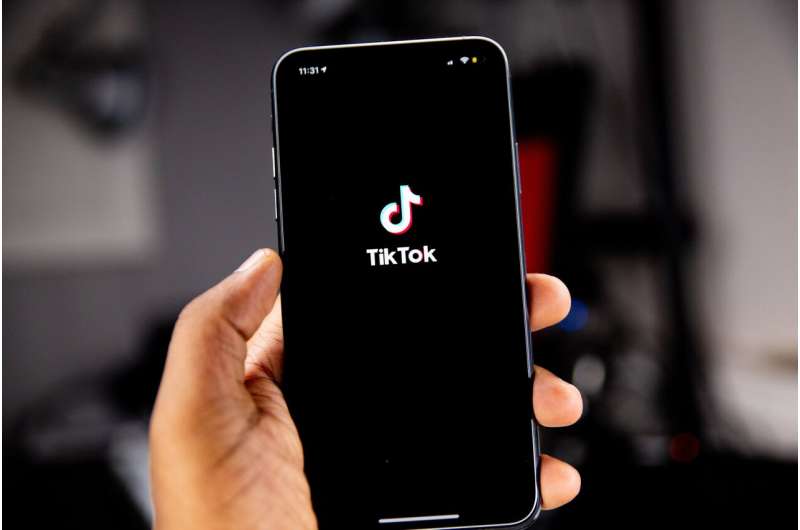This article has been reviewed according to Science X's editorial process and policies. Editors have highlighted the following attributes while ensuring the content's credibility:
fact-checked
peer-reviewed publication
trusted source
proofread
Researchers explore effect of Instagram, TikTok on psychological well-being

Instagram and TikTok are two of the fastest-growing social media outlets in the U.S., offering entertainment and connection to a world-wide community with the ease of a finger swipe. Despite their growing popularity, little research has focused on the association between the specific use of Instagram and TikTok and a person's psychological well-being.
Noted Baylor University smartphone researchers Meredith E. David, Ph.D., Associate Professor of Marketing, and James A. Roberts, Ph.D., The Ben H. Williams Professor of Marketing in the Hankamer School of Business, have investigated the correlation between the "flow states"—or happiness experienced by individuals—while using Instagram and TikTok and psychological well-being.
David and Roberts published their research—"Instagram and TikTok Flow States and Their Association with Psychological Well-Being"—in Cyberpsychology, Behavior, and Social Networking.
The study surveyed 420 U.S. adults to investigate the flow states experienced when using Instagram and TikTok and whether these flow states differentially impact well-being. A flow state is achieved when people are so engrossed in an activity that little else seems to matter to them and they will often continue the activity despite its negative consequences.
There are 5 flow dimensions:
- Focused Attention (immersion while using social media)
- Enjoyment (fun experienced while using social media)
- Curiosity (the desire to keep up with what's happening on a social media site)
- Telepresence (immersion in a world created by the social media experience
- Time Distortion (losing a sense of time while on social media)
The study determined that telepresence is the key component of flow that drives problematic social media behaviors and addiction. Telepresence for both Instagram and TikTok users was associated with higher levels of addiction, mind wandering, FOMO, anxiety and depression. The study revealed that 28% of Instagram users and 24% of TikTok users in the study would qualify as addicted based upon the diagnostic criteria.
These social media platforms may provide an escape from everyday worries, but if overused, they are a poor coping strategy, David said.
"It is likely that immersion in the world created by the social media experience displaces the more meaningful and close interpersonal relationships on which our psychological well-being depends," David said.
Differences between Instagram and TikTok users
Typically, the experience of flow is assumed to be similar across social media platforms, but this was not the case with Instagram and TikTok, researchers discovered. TikTok users report higher levels of overall flow, enjoyment and time distortion than Instagram users. A high telepresence was found in 53% of TikTok users but only 38% of Instagram users. This difference in flow composition suggests important differences may exist in how individuals experience flow across different social media platforms.
For example, Instagram is more personal in nature. Users post photos and comment on posts within a more intimate circle of friends while TikTok videos are shared with a larger network of friends, followers and often strangers with the primary purpose to entertain and garner likes, comments and shares.
TikTok users have fun watching the many short videos on the app, which provides constant reinforcement to continue watching videos. This behavior leads to higher levels of the flow state time distortion. In the study, TikTok users reported they were more prone to lose track of time and spend more time than they had intended. They also reported becoming so engrossed in scrolling through videos that they continued the activity despite its negative consequences.
Overcoming negative impacts
The negative impacts of time distortion and telepresence can be mitigated by spending less time on apps. Roberts recommends:
- Using the screen-time management settings available on most social media apps.
- Designating a parent, spouse or an accountability partner to help monitor the time an individual spends on social media.
- Stopping app use after a predetermined amount of time helps strengthen an individual's ability to practice restraint the next time they use social media.
Ultimately what determines the positive or negative effects of social media is dictated by the individual user.
"When overused as a replacement for true connections and communications, social media can be addictive and detrimental to well-being," David said. "In small doses it can fulfill curiosity, entertain and even educate. Used intentionally, social media can be a useful tool for connecting with others and fostering established relationships."
More information: James A. Roberts et al, Instagram and TikTok Flow States and Their Association with Psychological Well-Being, Cyberpsychology, Behavior, and Social Networking (2023). DOI: 10.1089/cyber.2022.0117
Journal information: Cyberpsychology, Behavior, and Social Networking
Provided by Baylor University





















